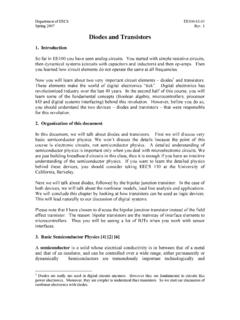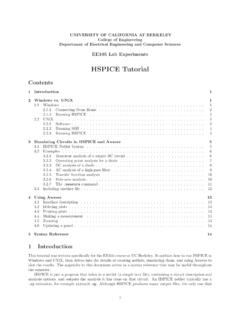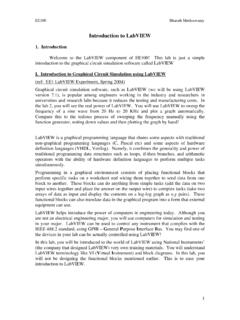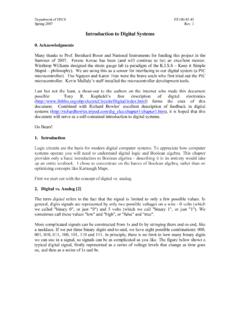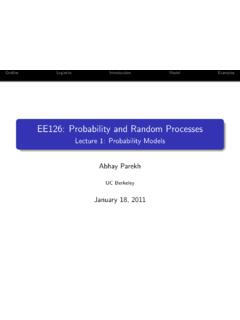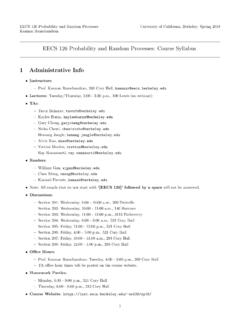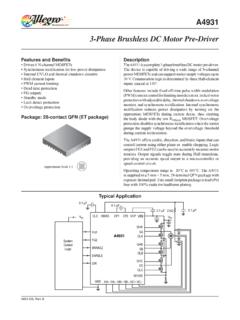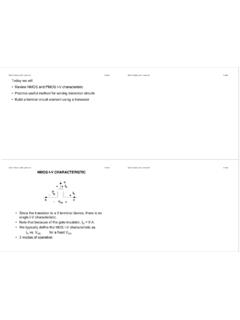Transcription of Databases Model the Real World The Entity- “Data Model ...
1 The Entity- Relationship ModelR &G - Chapter 2A relationship, I think, is like ashark, you know? It has toconstantly move forward or itdies. And I think what we got onour hands is a dead Allen (from Annie Hall, 1979) Databases Model the real World data Model allows us to translate real worldthings into structures computers can store Many models: Relational, E-R, O-O, Network,Hierarchical, etc. Relational Rows & Columns Keys & Foreign Keys to link in database Design Requirements Analysis user needs; what must database do? Conceptual Design high level descr (often done w/ER Model ) Logical Design translate ER into DBMS data Model Schema Refinement consistency, normalization Physical Design - indexes, disk layout Security Design - who accesses what, and howConceptual Design What are the entities and relationships in theenterprise? What information about these entities andrelationships should we store in the database ? What are the integrity constraints or businessrules that hold?
2 A database `schema in the ER Model can berepresented pictorially (ER diagrams). Can map an ER diagram into a Model Basics entity : real - World object, distinguishable fromother objects. An entity is described using a setof attributes. entity Set: A collection of similar entities. ,all employees. All entities in an entity set have the same setof attributes. (Until we consider hierarchies,anyway!) Each entity set has a key (underlined). Each attribute has a Model Basics (Contd.) Relationship: Association among two or more , Attishoo works in Pharmacy department. relationships can have their own attributes. Relationship Set: Collection of similar relationships. An n-ary relationship set R relates n entity sets E1 .. En ;each relationship in R involves entities e1 E1, .., en EnlotnameEmployeesssnWorks_Insincednameb udgetdidDepartmentsER Model Basics (Cont.) Same entity set can participate in differentrelationship sets, or in different roles inthe same Constraints An employee canwork in manydepartments; adept can havemany ManyMany-to-ManysinceManagesdnamebudgetd idDepartmentssinceWorks_InlotnamessnEmpl oyeesIn contrast, each depthas at most onemanager, accordingto the key constrainton Constraints Does every employee work in a department?
3 If so, this is a participation constraint the participation of Employees in Works_In is said to betotal (vs. partial) What if every department has an employee working in it? Basically means at least one lotnamednamebudgetdidsincenamednamebudge tdidsinceManagessinceDepartmentsEmployee sssnWorks_InMeans: exactly one Weak EntitiesA weak entity can be identified uniquely only byconsidering the primary key of another(owner) entity . Owner entity set and weak entity set mustparticipate in a one-to-many relationship set (oneowner, many weak entities). Weak entity set must have total participation inthis identifying relationship entities have only a partial key (dashed underline)Binary vs. Ternary RelationshipsIf each policy isowned by just 1employee:Bad designBeneficiaryagepnameDependentspolic yidcostPoliciesPurchasernameEmployeesssn lotBetter design Think through allthe constraints inthe 2nd diagram!PoliciespolicyidcostagepnameDepe ndentsCoversnameEmployeesssnlot Key constraint onPolicies wouldmean policy canonly cover 1dependent!
4 Binary vs. Ternary Relationships (Contd.) Previous example illustrated a case when two binaryrelationships were better than one ternaryrelationship. An example in the other direction: a ternary relationContracts relates entity sets Parts, Departments andSuppliers, and has descriptive attribute qty. Nocombination of binary relationships is an vs. Ternary Relationships (Contd.) S can-supply P, D needs P, and D deals-with S doesnot imply that D has agreed to buy P from S. How do we record qty? so far Entities and entity Set (boxes) Relationships and Relationship sets (diamonds) binary n-ary Key constraints (1-1,1-M, M-M, arrows on 1 side) Participation constraints (bold for Total) Weak entities - require strong entity for key Next, a couple more advanced to Model arelationshipinvolving arelationship us to treat arelationship setas an entity setfor purposes ofparticipation in(other)relationships. Aggregation vs. ternary relationship?
5 Monitors is a distinct relationship, with adescriptive attribute. Also, can say that each sponsorship ismonitored by at most one Design Using the ER Model ER modeling can get tricky! Design choices: Should a concept be modeled as an entity or an attribute? Should a concept be modeled as an entity or a relationship? Identifying relationships: Binary or ternary? Aggregation? Note constraints of the ER Model : A lot of data semantics can (and should) be captured. But some constraints cannot be captured in ER diagrams. We ll refine things in our logical (relational) designEntity vs. Attribute Should address be an attribute of Employeesor an entity (related to Employees)? Depends upon how we want to use addressinformation, and the semantics of the data : If we have several addresses per employee,address must be an entity (since attributescannot be set-valued). If the structure (city, street, etc.) is important,address must be modeled as an entity (sinceattribute values are atomic).
6 entity vs. Attribute (Cont.) Works_In2 does notallow an employee towork in a departmentfor two or more periods. Similar to the problem ofwanting to record severaladdresses for anemployee: we want torecord several values ofthe descriptive attributesfor each instance of vs. RelationshipOK as long as amanager gets aseparatediscretionary budget(dbudget) for if manager sdbudget covers allmanaged depts?(can repeat value, butsuch redundancy isproblematic)Manages2namednamebudgetdid EmployeesDepartmentsssnlotdbudgetsinceEm ployeessincenamednamebudgetdidDepartment sssnlotMgr_Apptsis_managerdbudgetapptnum managed_byNow you try itTry this at home - Courses database : Courses, Students, Teachers Courses have ids, titles, credits, .. Courses have multiple sections that have time/rmand exactly one teacher Must track students course schedules and transcriptsincluding grades, semester taken, etc. Must track which classes a professor has taught database should work over multiple semestersThese things get pretty hairy!
7 Many E-R diagrams cover entire walls! A modest example:A Cadastral E-R Diagramcadastral: showing or recording property boundaries, subdivision lines,buildings, and related detailsSource: US Dept. Interior Bureau of Land Management,Federal Geographic data Committee Cadastral ER to Relational Fairly analogous structure But many simple concepts in ER are subtle tospecify in relationsLogical DB Design: ER to Relational entity sets to tables. CREATE TABLE Employees (ssn CHAR(11), name CHAR(20), lot INTEGER, PRIMARY KEY (ssn))Employeesssnnamelotssnnamelot123-2 2-3666 Attishoo48231-31-5368 Smiley22131-24-3650 Smethurst35 Relationship Sets to Tables In translating a many-to-manyrelationship set to a relation,attributes of the relation mustinclude:1) Keys for each participatingentity set (as foreignkeys). This set of attributesforms a superkey for ) All descriptive TABLE Works_In( ssn CHAR(1), did INTEGER, since DATE, PRIMARY KEY (ssn, did), FOREIGN KEY (ssn) REFERENCES Employees, FOREIGN KEY (did) REFERENCES Departments)ssndidsince123-22-3666511/1/ 91123-22-3666563/3/93231-31-5368512/2/92 Review: Key Constraints Each dept has atmost onemanager,according to thekey constraint to relational Model ?
8 Many-to-Many1-to-11-to ManyMany-to-1dnamebudgetdidsincelotnames snManagesEmployeesDepartmentsTranslating ER with Key Constraints Since each department has a unique manager, wecould instead combine Manages and TABLE Manages( ssn CHAR(11), did INTEGER, since DATE, PRIMARY KEY (did), FOREIGN KEY (ssn)REFERENCES Employees, FOREIGN KEY (did)REFERENCES Departments)CREATE TABLE Dept_Mgr( did INTEGER, dname CHAR(20), budget real , ssn CHAR(11), since DATE, PRIMARY KEY (did), FOREIGN KEY (ssn) REFERENCES Employees) : Participation Constraints Does every department have a manager? If so, this is a participation constraint: the participation ofDepartments in Manages is said to be total (vs. partial). Every did value in Departments table must appear in arow of the Manages table (with a non-null ssn value!)lotnamednamebudgetdidsincenamedna mebudgetdidsinceManagessinceDepartmentsE mployeesssnWorks_InParticipation Constraints in SQL We can capture participation constraints involving one entityset in a binary relationship, but little else (without resorting toCHECK constraints which we ll learn later).
9 CREATE TABLE Dept_Mgr( did INTEGER, dname CHAR(20), budget real , ssn CHAR(11) NOT NULL, since DATE, PRIMARY KEY (did), FOREIGN KEY (ssn) REFERENCESE mployees, ON DELETE NO ACTION)Review: Weak Entities A weak entity can be identified uniquely only byconsidering the primary key of another (owner) entity . Owner entity set and weak entity set must participate in aone-to-many relationship set (1 owner, many weakentities). Weak entity set must have total participation in thisidentifying relationship Weak entity Sets Weak entity set and identifying relationshipset are translated into a single table. When the owner entity is deleted, all owned weakentities must also be TABLE Dep_Policy ( pname CHAR(20), age INTEGER, cost real , ssn CHAR(11) NOT NULL, PRIMARY KEY (pname, ssn), FOREIGN KEY (ssn) REFERENCES Employees, ON DELETE CASCADE)Summary of Conceptual Design Conceptual design follows requirements analysis, Yields a high-level description of data to be stored ER Model popular for conceptual design Constructs are expressive, close to the way people thinkabout their applications.
10 Note: There are many variations on ER Model Both graphically and conceptually Basic constructs: entities, relationships, and attributes (ofentities and relationships). Some additional constructs: weak entities, ISA hierarchies(see text if you re curious), and of ER (Cont.) Several kinds of integrity constraints: key constraints participation constraints Some foreign key constraints are also implicit inthe definition of a relationship set. Many other constraints (notably, functionaldependencies) cannot be expressed. Constraints play an important role in determiningthe best database design for an of ER (Cont.) ER design is subjective. There are often many ways tomodel a given scenario! Analyzing alternatives can be tricky, especially for a largeenterprise. Common choices include: entity vs. attribute, entity vs. relationship, binary or n-ary relationship, whether or not to use ISA hierarchies,aggregation. Ensuring good database design: resulting relationalschema should be analyzed and refined further.
